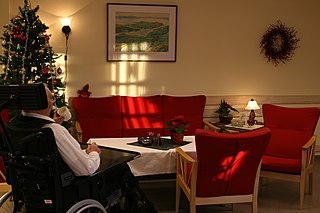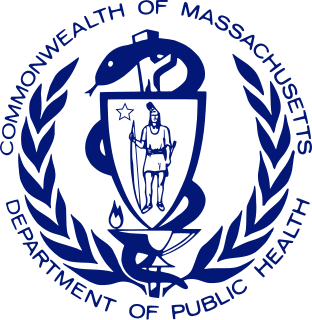Elder abuse is "a single, or repeated act, or lack of appropriate action, occurring within any relationship where there is an expectation of trust, which causes harm or distress to an older person." This definition has been adopted by of the World Health Organization (WHO) from a definition put forward by Action on Elder Abuse in the UK. Laws protecting the elderly from abuse are similar to and related to laws protecting dependent adults from abuse.

Elderly care, or simply eldercare, serves the needs and requirements of senior citizens. It encompasses assisted living, adult daycare, long-term care, nursing homes, hospice care, and home care. Because of the wide variety of elderly care needs and cultural perspectives on the elderly, it includes a broad range of practices and institutions. For example, government-run elderly care is seldom used in many Asian countries, where younger generations often care for the elderly.
The USC Leonard Davis School of Gerontology is one of the seventeen academic divisions of the University of Southern California in Los Angeles, focusing in undergraduate and graduate programs in gerontology,
Early childhood intervention (ECI) is a support and educational system for very young children who have been victims of, or who are at high risk for child abuse and/or neglect as well as children who have developmental delays or disabilities. Some states and regions have chosen to focus these services on children with developmental disabilities or delays, but Early Childhood Intervention is not limited to children with these disabilities.

Fall prevention includes any action taken to help reduce the number of accidental falls suffered by susceptible individuals, such as the elderly (idiopathic) and people with neurological or orthopedic indications.
A patient safety organization (pso) is a group, institution, or association that improves medical care by reducing medical errors. Common functions of patient safety organizations are data collection and analysis, reporting, education, funding, and advocacy. A pso differs from a Federally designed Patient Safety Organization (PSO), which provides health care providers in the U.S. privilege and confidentiality protections for efforts to improve patient safety and the quality of patient care delivery
Gerontechnology is an inter- and multidisciplinary academic and professional field combining gerontology and technology. Sustainability of an aging society depends upon our effectiveness in creating technological environments, including assistive technology and inclusive design, for innovative and independent living and social participation of older adults in any state of health, comfort and safety. In short, gerontechnology concerns matching technological environments to health, housing, mobility, communication, leisure and work of older people. Gerontechnology is most frequently identified as a subset of HealthTech and is more commonly referred to as AgeTech in Europe and the United States. Research outcomes form the basis for designers, builders, engineers, manufacturers, and those in the health professions, to provide an optimum living environment for the widest range of ages.
Program of All-inclusive Care for the Elderly (PACE) are programs within the United States that provide comprehensive health services for individuals age 55 and over who are sufficiently frail to be categorized as "nursing home eligible" by their state's Medicaid program. The ultimate goal of PACE programs is to keep eligible older adults out of nursing homes and within their communities for as long as possible. Services include primary and specialty medical care, nursing, nutrition, social services, therapies, pharmaceuticals, day health center services, home care, health-related transportation, minor modification to the home to accommodate disabilities, and anything else the program determines is medically necessary to maximize a member's health. If you or a loved one are eligible for nursing home level care but prefer to continue living at home, a PACE program can provide expansive health care and social opportunities during the day while you retain the comfort and familiarity of your home outside of day hours.

The Massachusetts Department of Public Health is a governmental agency of the Commonwealth of Massachusetts with various responsibilities related to public health within that state. It is headquartered in Boston and headed by Commissioner Monica Bharel.

A caregiver or carer is a paid or unpaid member of a person's social network who helps them with activities of daily living. Since they have no specific professional training, they are often described as informal caregivers. Caregivers most commonly assist with impairments related to old age, disability, a disease, or a mental disorder.
The U.S. Centers for Disease Control and Prevention defines aging in place as "the ability to live in one's own home and community safely, independently, and comfortably, regardless of age, income, or ability level".

Falls in older adults are a significant cause of morbidity and mortality and are a major class of preventable injuries. Falling is one of the most common accidents that cause a loss in the quality of life for older adults, and is usually precipitated by a loss of balance and weakness in the legs. The cause of falling in old age is often multifactorial and may require a multidisciplinary approach both to treat any injuries sustained and to prevent future falls. Falls include dropping from a standing position or from exposed positions such as those on ladders or stepladders. The severity of injury is generally related to the height of the fall. The state of the ground surface onto which the victim falls is also important, harder surfaces causing more severe injury. Falls can be prevented by ensuring that carpets are tacked down, that objects like electric cords are not in one's path, that hearing and vision are optimized, dizziness is minimized, alcohol intake is moderated and that shoes have low heels or rubber soles.
The California Department of Alcohol and Drug Programs (ADP) was a California state agency concerned with substance abuse prevention and treatment. Created by the California Legislature in 1978, ADP brought together the Governor's Office of Alcoholism and the California Department of Health's Division of Substance Abuse to form the single state authority for substance abuse prevention and treatment, and is currently within the auspices of the California Health and Human Services Agency. In this capacity, ADP provided leadership and policy coordination for the planning, development, implementation, and evaluation of a comprehensive statewide system of alcohol and other drug (AOD) prevention, treatment and recovery services. As of July 1, 2013, functions of ADP were transferred to the Department of Health Care Services.

The Older Americans Act of 1965 was the first federal level initiative aimed at providing comprehensive services for older adults. It created the National Aging Network comprising the Administration on Aging on the federal level, State Units on Aging at the state level, and Area Agencies on Aging at the local level. The network provides funding – based primarily on the percentage of an area's population 60 and older – for nutrition and supportive home and community-based services, disease prevention/health promotion services, elder rights programs, the National Family Caregiver Support Program, and the Native American Caregiver Support Program.
Guided Care is a model of proactive, comprehensive health care for people with several chronic conditions. A form of medical home, the model has been developed and tested by a multidisciplinary team of experts at the Roger C. Lipitz Center for Integrated Health Care in the Johns Hopkins Bloomberg School of Public Health. Guided Care is provided by physician-nurse teams in primary care practices to the physicians' most complex patients, mainly older adults with chronic conditions and complicated health needs. It is designed to increase patients' quality of care and quality of life, while improving the efficiency of their use of health care resources, thus reducing their overall health care costs.
The Pennsylvania Department of Aging is a cabinet-level agency charged with providing aid to Pennsylvania's approximately three million individuals age 60 and older. Although the bureau operates some services directly, such as the Pharmaceutical Contact for the Elderly (PACE) prescription drug program, it generally serves as a clearinghouse of funding and information for county-level Area Agencies on Aging. The department was formed under the governorship of Milton Shapp.
In the United States there are approximately 50 million people who are caring at home for family members including elderly parents, and spouses and children with disabilities and/or chronic illnesses. Without this home-care, most of these cared for would require permanent placement in institutions or health care facilities.

The LGBT Aging Project is a Boston-based non-profit organization dedicated to ensuring that lesbian, gay, bisexual, and transgender older adults have equal access to life-prolonging benefits, protection, services and institutions as heterosexual and cisgender adults. Founded in 2001, the project provides cultural competence and institutional capacity training to elder service providers on how to create and sustain LGBT welcoming environments, develop community-building programs for LGBT older adults and caregivers, and also works to enact policy and legislative changes to improve access to care and benefits for LGBT elders.. The LGBT Aging Project was featured in the 2010 award-winning documentary Gen Silent.
Barbara Barlow is an American pediatric surgeon who was the first woman to train in pediatric surgery at Babies Hospital, present-day Morgan Stanley Children's Hospital. She has also reduced the amount of injuries for inner-city children through her research and efforts to educate the public on prevention of accidents.

National Safety Month (NSM) is an annual month-long observance in the United States each June.







